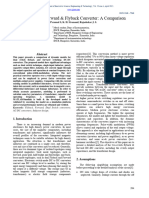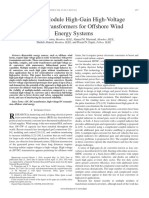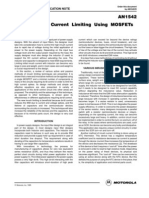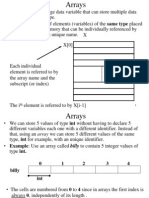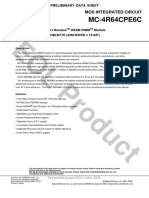Ijert Ijert: A New Topology For 31-Level Cascaded Multilevel Inverter With Reduced Number of Switches
Ijert Ijert: A New Topology For 31-Level Cascaded Multilevel Inverter With Reduced Number of Switches
Uploaded by
dishore312Copyright:
Available Formats
Ijert Ijert: A New Topology For 31-Level Cascaded Multilevel Inverter With Reduced Number of Switches
Ijert Ijert: A New Topology For 31-Level Cascaded Multilevel Inverter With Reduced Number of Switches
Uploaded by
dishore312Original Description:
Original Title
Copyright
Available Formats
Share this document
Did you find this document useful?
Is this content inappropriate?
Copyright:
Available Formats
Ijert Ijert: A New Topology For 31-Level Cascaded Multilevel Inverter With Reduced Number of Switches
Ijert Ijert: A New Topology For 31-Level Cascaded Multilevel Inverter With Reduced Number of Switches
Uploaded by
dishore312Copyright:
Available Formats
International Journal of Engineering Research & Technology (IJERT)
ISSN: 2278-0181
Vol. 2 Issue 9, September - 2013
A New Topology for 31-Level Cascaded Multilevel Inverter
With Reduced Number of Switches
Ch.Sajan T.Praveen Kumar K.Srilatha
Associate professor, Associate professor, P.G. student,
Dept of EEE, Dept of EEE, Dept of EEE,
Jyothishmathi Institute Jyothishmathi Institute Jyothishmathi Institute
of technology & science, of technology & science, of technology & science,
Karimnagar, A.P., India Karimnagar, A.P., India Karimnagar, A.P., India
I. Introduction
Abstract Numerous industrial applications have begun
to require high power apparatus in recent years.
In this paper, a new topology is composed of Multilevel inverters have become more popular
Voltage sources that are connected in over the years in industrial propel applications and
series/parallel by the switching devices makes it high power applications with the promise of less
RT
easily extensible to higher number of output voltage disturbances, smaller common-mode voltage, the
levels associated with less number of switches, possibility to function at lower switching
capacitors, gate driver circuits, protection circuits frequencies, and good potential for further
IJE
for switches and blocking voltage on switches. The developments than ordinary two-level inverters.
size, complexity and power consumption in the gate Though Conventional two-level inverters are
driving circuits is also reduced. Reduction of rating effective, but create harmonic distortions in the
of the switches is another advantage. The total output voltage, EMI and high dv/dt (compared to
harmonic distortion (THD) is reduced with more multilevel inverters). As a result the most
number of steps in output voltage without using attractive applications of multilevel inverters are in
pulse width modulation techniques. This topology is the medium to high voltage ranges. The concept of
proposed to get high 31 levels. Simulation results Multilevel Inverters does not depend on just two
are shown and compared with theoretical results. levels of voltage to create an AC signal. Instead
In the asymmetric topologies, the values of dc several voltage levels are added to each other to
voltage sources magnitudes are unequal or create a smoother stepped waveform with lower
changed dynamically. If the voltage sources are dv/dt and lower harmonic distortions. With more
changed during the converter operation, the voltage levels in the inverter, the waveform
voltage balancing should be done for active power becomes smoother, but with many levels the
transfer. In this paper voltage balancing technique design becomes more complicated, with more
is analyzed for cascaded multilevel inverter which components. A multilevel converter not only
shows how to operate the converter in order to achieves high power rating, but also enables the
maintain equal charge/discharge rates from the dc use of renewable energy sources such as
sources and Simulation results for active power photovoltaic, wind, and fuel cells can be easily
transfer & reactive power transfer are shown. interfaced to a multilevel converter system for a
high power application. Proposed topology has
fewer switches than that of in symmetric topology.
Several multilevel inverter topologies have
been developed like flying capacitor, neutral point
clamped, Cascaded H-bridge (CHB). Among these
IJERTV2IS90673 www.ijert.org 1883
International Journal of Engineering Research & Technology (IJERT)
ISSN: 2278-0181
Vol. 2 Issue 9, September - 2013
topologies, the cascaded H bridge inverter has II. Proposed Topology
received much attention. The advantages of In this paper, the proposed multilevel inverter
cascaded multilevel inverters are: not only has the modularity feature of cascaded
Requires less number of components per topologies but also consists of the ability of series
level and parallel connections of dc voltage sources.
Modularized structure without clamping Series and parallel connections of the dc voltage
components sources increase the output voltage levels or given
Possibility to implement soft-switching current to the multilevel inverter, respectively. In
the proposed topology, the magnitude of the dc
Simple voltage balancing modulation. voltage sources differs from one unit to another.
And disadvantages are:
Needs separate isolated DC sources for
real power transfer
No common DC-bus
The proposed topology is of cascaded
multilevel inverter with asymmetrical
configuration, since it uses several levels of dc
voltage sources, which would be available from
batteries, ultra capacitors, or fuel cells. Because of
these several levels of dc sources may cause
voltage unbalances which leads to the increase of
harmonics and total harmonic distortion. Proposed Figure 1. Proposed basic unit.
topology shows how to operate this converter in
order to maintain equal charge/discharge rates When the switches S0 and Sc1 become ON,
from the dc sources. This is called voltage the voltage level at the output is zero. By turning
RT
balancing technique in the multilevel inverter. on the switches S1, Sb1, and Sc1, the two dc
With this technique the harmonic content is also voltage sources are paralleled and Vdc is produced
reduced. Since switching frequency is restricted by at the output. Similarly, when the switches S1 and
IJE
switching losses in high power and high voltage Sa1 become ON, the two dc voltage sources could
applications, multilevel inverters have found wide be connected in series and 2Vdc is produced at the
acceptance as they can achieve a low harmonic output as shown in table 1.
component with low switching frequency.
Furthermore, low blocking voltage by switching Table 1. Switching sequence for Basic unit.
devices is the other advantage of this type of
converters as well as minimum harmonic
distortion and switching losses.
The blocked voltage by each switch in a
specific unit is same as the other switches used in
the same unit and is equal to the magnitude of the
dc voltage source used in the unit. Therefore, the
number of gate driving circuits is reduced and as a
result the size of multilevel inverter and its power
consumption are reduced. Another feature of the
proposed topology is that there is any kind of
necessity to bidirectional switches. In this paper, a
new procedure is recommended to find out the
magnitude of the dc voltage sources and produce
all output voltage levels. Finally, a method to find
out the optimal number of switches and dc voltage
sources so that have the maximum output voltage
levels with the minimum blocked voltage by
switches is presented.
IJERTV2IS90673 www.ijert.org 1884
International Journal of Engineering Research & Technology (IJERT)
ISSN: 2278-0181
Vol. 2 Issue 9, September - 2013
III. Principle of Operation In a conventional cascaded multilevel inverter,
the number of output phase voltage levels is
defined by, n= 2m+1, where m is the number of
dc voltage sources. Each H-bridge requires a dc
source and 4 switches. 12 switching devices are
needed for 7 levels, 16 switching devices are
needed for 9 levels, and 20 switching devices are
needed for 31 levels, which make an inverter
complicated.
RT
Figure 2. Proposed Topology for n-level
IJE
The proposed topology of multilevel inverter
for n-level is shown in Figure 2. It consists of three
bridges that are two upper H-bridges and the lower
H-bridge with series/parallel circuit, which are
cascaded. The principle of operation of lower H-
bridge with series/parallel circuit is shown in table
2. By using this principle high numbers of steps
are obtained at output.
Table 2. Principle of operation of series/parallel
circuit Figure 3. For 31-level output.
But the proposed inverter outputs 12n +7
levels, where n is number of dc voltage sources in
series/parallel circuit. Total number of switching
devices required is 3n + 9, which makes the output
voltage of the inverter almost sinusoidal. Figure 3.
shows the proposed topology for 31 level output, it
consists of 2 voltage sources in the series/parallel
circuit.
IJERTV2IS90673 www.ijert.org 1885
International Journal of Engineering Research & Technology (IJERT)
ISSN: 2278-0181
Vol. 2 Issue 9, September - 2013
Table 3. Switching sequence for 31 level output. IV. Design and Analysis
Switches closed Vout The Matlab/Simulink model of the proposed
S2,S4,S6,S8,S10,S12 0 inverter for 31 level output is shown in Figure 4. It
consists of two upper H-bridges are cascaded with
S9,S12 0.5Vo lower H-bridge of series/parallel circuit.
S5,S8 Vo Simulation is performed for the proposed circuit
S5,S8,S9,S12 1.5 Vo with MATLAB/SIMULINK.
Sc1,S1,S4,S6,S7 2 Vo
Sc1,S1,S4,S10,S11 2.5 Vo
Sc1,S1,S4 3 Vo
Sc1,S1,S4,S9,S12 3.5 Vo
Sc1,S1,S4, S5,S8 4 Vo
Sc1,S1,S4,S5,S8,S9,S12 4.5 Vo
Sa1,S1,S4,S6,S7 5 Vo
Sa1,S1,S4,S10,S11 5.5 Vo
Sa1,S1,S4 6 Vo
Sa1,S1,S4,S9,S12 6.5 Vo
Sa1,S1,S4,S5,S8 7 Vo
Sa1,S1,S4,S5,S8,S9,S12 7.5 Vo
S10,S11 -0.5 Vo
S6,S7 - Vo
RT
S6,S7, S10,S11 -1.5 Vo
Sc1, S2,S3,S5,S8 -2Vo Figure 4. Mat lab/Simulink model for 31 level
output.
IJE
Sc1, S2,S3, S9,S12 -2.5 Vo
Sc1, S2,S3 -3 Vo
Sc1, S2,S3, S10,S11 -3.5 Vo
Sc1, S2,S3, S6,S7 -4 Vo
Sc1,S2,S3,S6,S7,S10,S11 -4.5 Vo
Sa1,S2,S3,S5,S8 -5 Vo
Sa1,S2,S3, S9,S12 -5.5 Vo
Sa1,S2,S3 -6 Vo
Sa1,S2,S3, S10,S11 -6.5 Vo
Sa1,S2,S3, S6,S7 -7 Vo
Sa1,S2,S3, S6,S7,S10,S11 -7.5 Vo
Assuming the voltage ratio for 31 level Figure 5. Simulation result for 31 level output.
cascaded multilevel inverter voltage sources as
1:2:6, the inverter requires 15 switching devices 5V for first upper H-bridge, 10V for second
for 31 levels, which is shown in Figure 3. Two upper H-bridge, and two voltage sources of
voltage sources are required in series/parallel series/parallel circuit are 30V each maintaining the
circuit, levels are obtained by the Eq. (1) and the ratio of 1:2:6, then the amplitude of the inverter’s
switching sequence is shown in Table 3. output voltage waveform for 31 levels is 73.3V.
V𝑜𝑢𝑡=𝑣1+𝑣2+𝑣3 (1)
IJERTV2IS90673 www.ijert.org 1886
International Journal of Engineering Research & Technology (IJERT)
ISSN: 2278-0181
Vol. 2 Issue 9, September - 2013
which uses lesser number of bridges. This scheme
therefore provides the capability to produce higher
voltages at higher speeds with low switching
frequency which has inherent low switching losses
and high converter efficiency. Although the
cascaded converter has an inherent self-balancing
characteristic, a slight voltage imbalance can occur
because of the circuit component losses.
Obviously, the primary attraction of the Cascaded
Multilevel converter topology is its modularity.
However, Cascaded topology requires an
excessive amount of DC voltage sources. The most
important factors causing the voltage imbalance
among these DC capacitors are the difference in
the power stage losses and the component
Figure 6. Experimental 31-level output voltage tolerances. The internal losses may be differently
and current. influenced by the switching and conduction
activity and the component tolerances. To achieve
Figure 5 and Figure 6 shows the 31 level steady-state, balanced voltages, these DC
output Voltage and current Waveforms without capacitors must have the same amount of real
PWM. It is clear that as the number of level power utilization in a given period of time. Due to
increases, distortion reduces. Switches required in sharing the same output current, the differences in
the proposed topology compared to other the capacitor currents are caused by the different
topologies are shown in figure 7. duty cycles, because a capacitor current is a
product of a duty cycle and an output current.
Therefore, the average switching functions or duty
RT
cycles in these H-bridge converters must be
identical.
IJE
VI. Voltage-Balancing Technique
The Cascaded Multilevel Inverter with its use
of several voltage sources is suitable in Electric
Vehicles (EV) since battery cells is the power
source. The battery cells may not always be equal
and depending on the output demand the cells may
be discharged unequally. The above proposed
topology is composed of series basic units which
Figure 7. Comparison with other topologies are consisted of series and parallel connections of
dc voltage sources. The values of the dc voltage
From the above figure it is shown that less sources differ from one unit to another. Even
number of switches are required in the proposed though the same output voltages are generated, the
topology. Hence complexity is reduced for high currents flowing in the circuits have different
number of levels. paths. This means that different DC capacitors see
different current waveforms. Consequently, the
V. Voltage Balancing DC capacitors have different voltage profiles. It is
Asymmetric multilevel inverters have the same therefore important to investigate the voltage
topology as symmetric multilevel inverters. They source unbalance problem in the Cascaded
differ only in the rating of input dc voltages and Multilevel Inverters.
control strategies. For many applications it is The voltage unbalance problem can be solved
troublesome to use separate dc sources and too with the modulation by choosing a switch state
many dc sources will require many long cables and that corrects the unbalance. This can also be called
could lead to voltage imbalance among the dc prioritizing. By prioritizing in which order that
sources. To reduce the number of dc sources voltage sources are to be used the workload can be
required for the cascaded H-bridge multilevel divided between the sources so that they are held
inverter, Asymmetrical configuration is proposed balanced. The prioritizing order is dependent on
IJERTV2IS90673 www.ijert.org 1887
International Journal of Engineering Research & Technology (IJERT)
ISSN: 2278-0181
Vol. 2 Issue 9, September - 2013
the current direction and if voltage amplitude is models connected to each module capacitor,
negative or positive. If, for example, a capacitor in recharging them over time so that they do not run
a full-bridge module for the Cascaded Multilevel out of stored energy.
Inverter (CMI) has a higher charge (and therefore
higher potential) that certain module can be given
the heaviest workload during a period where the
capacitor is going to be discharged (positive
voltage and current owing to the load), lowering
the voltage closer to the wanted value. The
strategy can also work the other way around, to
charge capacitors with lower potential by
connecting them to the load, with positive
potential forward, when current is owing from the
load, or vice versa. However, this strategy is most
effective when transferring active power. When
transferring only reactive power the sources does
not get unbalanced and this balancing strategy is
not necessary.
VII. Design Example
Voltage balancing technique is well explained with
this following example, in which the simulation
model shown for 5-level cascaded multilevel
inverter.
RT
Figure 9. Simulation results of 5level CMI.
a) Reactive power transfer capacitor voltages.
b) Active/mixed power transfer capacitor voltages.
IJE
c) Reactive power transfer load voltage and
current. d) Active power transfer load voltage and
current.
VIII. Conclusion
Cascaded multilevel inverters in addition to
acceptable reliability and simple control, provide a
Figure 8. 5level Cascaded multilevel inverter better voltage waveform than the other types of
simulation model for voltage balancing. multilevel inverters. In this paper, a new cascaded
multilevel inverter topology was proposed which
The Cascaded Multilevel Inverter (CMI) with was connected to the dc voltage sources in series
its use of several voltage sources is suitable in and parallel. The suggested topology needs less
Electric Vehicles (EV) since battery cells is the number of switching devices with minimum
power source. The battery cells may not always be standing voltage. THD is also reduced without
equal and depending on the output demand the using modulation techniques. And the proposed
cells may be discharged unequally. It is therefore topology shows how to operate the Cascaded
important to investigate the voltage source multilevel inverter without any voltage unbalance
unbalance problem in the Cascaded multilevel problems. The simulation results are shown which
inverter. are accorded with the theoretical results. The
The 5 level CMI shown in above figure 8. is proposed inverter is used in high power
connected to an active/mixed power load and a applications like EV and HEV drives.
pure reactive power load can be seen. Each
capacitor where charged to 500V during the
beginning of the simulation with the charging
voltage source. The charging voltage source where
disconnected after the circuit reached steady-state
operation. It should be noted that there are battery
IJERTV2IS90673 www.ijert.org 1888
International Journal of Engineering Research & Technology (IJERT)
ISSN: 2278-0181
Vol. 2 Issue 9, September - 2013
IX. References [16] F.Z.Peng, J.S.Lai, J.W.McKeever and
[1]. P. Lezana, J. Rodriguez, and D. A. Oyarzun, J.A.Vancoevering, “Multilevel voltage source inverter
“Cascaded multilevel inverter with regeneration with separate dc sources for static var generation”, IEEE
capability and reduced number of switches,” IEEE Transactions on Industrial Applications, vol.32, no.5,
Trans. Ind. Electron., vol. 55, no. 3, pp. 1059– 1066, 1996, pp.1130-1138.
Mar. 2008.
[2] T.A. Meynard, H. Foch, P. Thomas, J. Courault, R.
Jakob, M. Nahrstaedt, “Multicell converters: Basic
concepts and industry applications”, IEEE Trans. Ind.
Electron. Vol. 49, pp. 955-964, 2002.
[3] Peng, F.Z.; , "A generalized multilevel inverter
topology with self voltage balancing," Industry
Applications Conference, 2000. Conference Record of
the 2000 IEEE , vol.3, no., pp.2024-2031 vol.3, 2000
doi: 10.1109/IAS.2000.882155
[4] Y. Hinago, H. Koizumi, “A single-phase multilevel
inverter using switched series/parallel dc voltage
sources”, IEEE Trans. Ind. Electron., Vol. 57, pp. 2643-
2650, 2010.
[5] K.A. Corzine, F.A. Hardrick, Y.L. Familiant, “A
cascaded multi-level H-bridge inverter utilizing
capacitor voltages sources”, in Proc. IASTAD Power
Electron. Technol. and Appl. Conf., 2003.
[6] G.A. Duba, E.S. Thaxton, J. Walter, “Modular static
power converter connected in a multi-level, multi-phase,
multi-circuit configuration”, U.S. Pat. 05933339, 1999.
[7] E.Babaei, “A cascade multilevel converter topology
with reduced number of switches”, IEEE Trans. Power
RT
Electron., Vol. 23, pp. 2657-2664, 2008.
[8] E. Babaei, “Optimal topologies for cascaded sub-
multilevel converters”, J. Of Power Electron., Vol. 10,
pp. 251-261, 2010.
IJE
[9] K.A. Corzine, M.W. Wielebski, F.Z. Peng, J Wang,
“Control of cascaded multilevel inverters”, IEEE Trans.
Power Electron., Vol. 19, pp. 732-738, 2004.
[10] J. Wen, K.M. Smedley, “Synthesis of multilevel
converters based on singleand/ or three-phase converter
building blocks”, IEEE Trans. Power Electron., Vol. 23,
pp. 1247-1256, 2008.
[11] S. Sunter and H. Altun, “A method for calculating
semiconductor losses in the matrix converter,” in Proc.
MELECON, 1998, pp. 1260–1264.
[12] K. A. Corzine, M. W. Wielebski, F. Z. Peng, and J.
Wang, “Control of Cascaded Multilevel Inverters,”
IEEE Trans. power electron, vol.19, no.3, pp. 732-738,
May 2004.
[13] Y. Liu, H. Hong, and A. Q. Huang, “Real-time
algorithm for minimizing THD in multilevel inverters
with unequal or varying voltage steps under staircase
modulation,” IEEE Trans. Ind. Electron., vol. 56, no. 6,
pp. 2249–2258, Jun. 2009.
[14] J. I. Leon, S. Vazquez, S. Kouro, L. G. Franquelo,
J. M. Carrasco, and, J. Rodriguez, “Unidimensional
modulation technique for cascaded multilevel
converters,” IEEE Trans. Ind. Electron., vol. 56, no. 8,
pp. 2981– 2986, Aug. 2009.
[15] P. Cortes, A. Wilson, S. Kouro, J. Rodriguez, and
H. Abu-Rub, “Model predictive control of multilevel
cascaded H-bridge inverters,” IEEE Trans. Ind.
Electron., vol. 57, no. 8, pp. 2691–2699, Aug. 2010.
IJERTV2IS90673 www.ijert.org 1889
You might also like
- U5l08 Activity Guide - Loops MakeDocument2 pagesU5l08 Activity Guide - Loops Makeapi-524141584100% (1)
- Useful Cli CommandsDocument10 pagesUseful Cli CommandsGeorge Chet WerbernjergenmanjensenNo ratings yet
- MPLT InformationDocument11 pagesMPLT InformationGonza PfNo ratings yet
- Multilevel Inverter With Reduced Number of Switching Losses: Suriaprakash.K, Balasubramanian.T, Dr. S.RameshDocument7 pagesMultilevel Inverter With Reduced Number of Switching Losses: Suriaprakash.K, Balasubramanian.T, Dr. S.RameshKUMARNo ratings yet
- A Generalized Undeland Snubber For Flying Capacitor Multilevel Inverter and ConverterDocument7 pagesA Generalized Undeland Snubber For Flying Capacitor Multilevel Inverter and ConverterMehdi YahiNo ratings yet
- 152 Ijitr-4-5-258 PDFDocument3 pages152 Ijitr-4-5-258 PDFarshadeee202No ratings yet
- Minimization of Total Harmonic Distorsion For Cascaded Multilevel Inverter With Reduced Number of SwitchesDocument5 pagesMinimization of Total Harmonic Distorsion For Cascaded Multilevel Inverter With Reduced Number of SwitchesijcnesNo ratings yet
- Ijiset V2 I4 27Document5 pagesIjiset V2 I4 27Armand SteynNo ratings yet
- Multi Level InverterDocument4 pagesMulti Level InverterabsalnabiNo ratings yet
- Multiple-Module High-Gain High-Voltage DC-DC Transformers For Offshore Wind Energy SystemsDocument10 pagesMultiple-Module High-Gain High-Voltage DC-DC Transformers For Offshore Wind Energy SystemsNguyễn Văn ĐạoNo ratings yet
- Development of Dual PV System With Field Programmable Gate Array (FPGA) For Multilevel InvertersDocument6 pagesDevelopment of Dual PV System With Field Programmable Gate Array (FPGA) For Multilevel InvertersMurtaza ALI KhooharoNo ratings yet
- Ieee 1Document7 pagesIeee 1tidato7346No ratings yet
- A Three-Phase Soft-Switched High-power-Density DC DC Converter For High-Power Applications Divan1991Document11 pagesA Three-Phase Soft-Switched High-power-Density DC DC Converter For High-Power Applications Divan1991Soumyadeep RoyNo ratings yet
- Novel Asymmetrical Multilevel Inverter Topology With Reduced Number of Switches For Photovoltaic ApplicationsDocument6 pagesNovel Asymmetrical Multilevel Inverter Topology With Reduced Number of Switches For Photovoltaic ApplicationsKRISHNA PRASADNo ratings yet
- A Comparison of Three-Level Converters Versus Two-Level Converters For Low-Voltage Drives, Traction, and Utility ApplicationsDocument11 pagesA Comparison of Three-Level Converters Versus Two-Level Converters For Low-Voltage Drives, Traction, and Utility ApplicationsSoujanya SoujiNo ratings yet
- Modified Common Ground Transformerless High Gain Dc-DcBuck-Boost ConverterDocument11 pagesModified Common Ground Transformerless High Gain Dc-DcBuck-Boost ConverterInternational Journal of Innovative Science and Research TechnologyNo ratings yet
- Rik W - 1991 - A Three-Phase Soft-Switched High-Power-Density DC - DC Converter For High-Power ApplicationsDocument11 pagesRik W - 1991 - A Three-Phase Soft-Switched High-Power-Density DC - DC Converter For High-Power ApplicationsashnajosephNo ratings yet
- A Novel Single-Input Dual-Output ThreeLevel DC-DC ConverterDocument11 pagesA Novel Single-Input Dual-Output ThreeLevel DC-DC ConvertersathishNo ratings yet
- Mli 2Document9 pagesMli 2Students Xerox ChidambaramNo ratings yet
- A Solar Power Generation System With A Seven-Level InverterDocument9 pagesA Solar Power Generation System With A Seven-Level InverterSyed ZadaaNo ratings yet
- Novel Zero-Current-Switching Current-Fed Half-Bridge Isolated DC DC Converter For Fuel-Cell-Based ApplicationsDocument11 pagesNovel Zero-Current-Switching Current-Fed Half-Bridge Isolated DC DC Converter For Fuel-Cell-Based ApplicationsHsekum RamukNo ratings yet
- Harmonics Optimization in Multilevel Inverter Using Real Coded Genetic AlgorithmDocument8 pagesHarmonics Optimization in Multilevel Inverter Using Real Coded Genetic AlgorithmyasinNo ratings yet
- WCECS2015 pp204-209 PDFDocument6 pagesWCECS2015 pp204-209 PDFMohamed RafiqNo ratings yet
- Ijert Ijert: Three Phase Parallel Multilevel Inverter Fed Induction Motor Using PD Modulation SchemeDocument4 pagesIjert Ijert: Three Phase Parallel Multilevel Inverter Fed Induction Motor Using PD Modulation SchemeR.SRIKANTHNo ratings yet
- A MEDIUM SCALE INDUCTION MACHINE - Vokas Theodorakis 2016 PDFDocument8 pagesA MEDIUM SCALE INDUCTION MACHINE - Vokas Theodorakis 2016 PDFtheodorakis017781No ratings yet
- Simulation of Cascade H-Bridge Multilevel Inverter With Equal DC Voltage SourceDocument5 pagesSimulation of Cascade H-Bridge Multilevel Inverter With Equal DC Voltage Sourceyr48No ratings yet
- A.G.Theodorakis1 G.A. Vokas1 P. Fergadiotis2Document8 pagesA.G.Theodorakis1 G.A. Vokas1 P. Fergadiotis2dimitris01spNo ratings yet
- Wireless Power Transfer WPT For Electric Vehicles Charging Evs Using Piezo Electric Sensors IJERTCONV4IS11031Document3 pagesWireless Power Transfer WPT For Electric Vehicles Charging Evs Using Piezo Electric Sensors IJERTCONV4IS11031ChandanNo ratings yet
- Development of New Converter TopologiesDocument21 pagesDevelopment of New Converter TopologiesFilip BjekićNo ratings yet
- IJETR032864Document5 pagesIJETR032864erpublicationNo ratings yet
- Bridgeless PushPull Resonant AC DC Converter Featuring Balanced Switching Loss DistributionDocument11 pagesBridgeless PushPull Resonant AC DC Converter Featuring Balanced Switching Loss Distribution하미드라힘No ratings yet
- 1 s2.0 S1110016823009511 MainDocument47 pages1 s2.0 S1110016823009511 Mainsubham DebnathNo ratings yet
- Ijert: T-Shaped Z-Source InverterDocument6 pagesIjert: T-Shaped Z-Source InverterR.SRIKANTHNo ratings yet
- 06 Design Implementation Highly Efficient PDFDocument10 pages06 Design Implementation Highly Efficient PDFEdamEdamNo ratings yet
- Science and MathematicsDocument6 pagesScience and Mathematicsp.maheswariopenventioNo ratings yet
- Design of A Novel Energy Efficient Double Tail Dynamic ComparatorDocument5 pagesDesign of A Novel Energy Efficient Double Tail Dynamic ComparatorerpublicationNo ratings yet
- Seminar 2Document9 pagesSeminar 2mohdaskar22No ratings yet
- Three Phase Inverter Switching Losses at Ambient Temperature ConditionsDocument4 pagesThree Phase Inverter Switching Losses at Ambient Temperature Conditionstwistedmis2No ratings yet
- Current Limiting TransformerDocument5 pagesCurrent Limiting TransformerJournalNX - a Multidisciplinary Peer Reviewed JournalNo ratings yet
- Mohammed 2020 IOP Conf. Ser. Mater. Sci. Eng. 881 012124Document17 pagesMohammed 2020 IOP Conf. Ser. Mater. Sci. Eng. 881 012124emcadena8No ratings yet
- Active Inrush Current LimitingDocument14 pagesActive Inrush Current Limitingskyfoggy4799No ratings yet
- Multilevel Inverter Topology With Self-Balancing Voltage and Modularity in DesignDocument11 pagesMultilevel Inverter Topology With Self-Balancing Voltage and Modularity in DesignIJRASETPublicationsNo ratings yet
- Comparison of Conventional New Multilevel Inverter Topology PDFDocument5 pagesComparison of Conventional New Multilevel Inverter Topology PDFchristopherNo ratings yet
- Operation of D Statcom in Voltage Control Mode IJERTV7IS090086Document8 pagesOperation of D Statcom in Voltage Control Mode IJERTV7IS090086harinijeyasri7No ratings yet
- Hybrid NPC CHBDocument10 pagesHybrid NPC CHBvahid barahoueiNo ratings yet
- Fyp PresenationDocument15 pagesFyp Presenationshoaib ehsanNo ratings yet
- Phase I.M DriveDocument4 pagesPhase I.M DriveJournalNX - a Multidisciplinary Peer Reviewed JournalNo ratings yet
- 2021-22-Eee - New Multilevel Inverter Topology With Reduce Switch Count-03Document4 pages2021-22-Eee - New Multilevel Inverter Topology With Reduce Switch Count-03subham DebnathNo ratings yet
- Publication 1Document11 pagesPublication 1aditya.gautamNo ratings yet
- An Analysis and Modeling of Grid Connected Multiple-Pole Multilevel Unity Power Factor RectifierDocument7 pagesAn Analysis and Modeling of Grid Connected Multiple-Pole Multilevel Unity Power Factor RectifierEditor IJTSRDNo ratings yet
- Packed U Cells Multilevel Converter Topology: Theoretical Study and Experimental ValidationDocument14 pagesPacked U Cells Multilevel Converter Topology: Theoretical Study and Experimental Validationmehdi bouallouNo ratings yet
- Report Final PDFDocument20 pagesReport Final PDFAtharva P JoshiNo ratings yet
- Topologies of SiInverters For Small DisDocument11 pagesTopologies of SiInverters For Small DisMuhammad Hamza FarooqNo ratings yet
- Soft Switched Interleaved DC DC ConverterDocument11 pagesSoft Switched Interleaved DC DC ConverterSatish RamNo ratings yet
- Development of Series Resonant Inverters For Induction Heating ApplicationsDocument5 pagesDevelopment of Series Resonant Inverters For Induction Heating ApplicationsVanshika JindalNo ratings yet
- Modified Seven-Level Pack U-Cell Inverter For Photovoltaic ApplicationsDocument9 pagesModified Seven-Level Pack U-Cell Inverter For Photovoltaic ApplicationsSPOOKY WARRIORSNo ratings yet
- Performance Evaluation of Asymmetricalcascaded Hbridge Multilevel InverterDocument10 pagesPerformance Evaluation of Asymmetricalcascaded Hbridge Multilevel InverterKrishna KamalNo ratings yet
- A Three-Phase Soft-Switched High-power-Density DC DC Converter For High-Power ApplicationsDocument11 pagesA Three-Phase Soft-Switched High-power-Density DC DC Converter For High-Power ApplicationsKenil BrahmbhattNo ratings yet
- Design and Implementation of A Highly Efficient Three-Level T-Type Converter For Low-VoltageDocument9 pagesDesign and Implementation of A Highly Efficient Three-Level T-Type Converter For Low-VoltageRakesh SandarativjuNo ratings yet
- Performance Analysis of Cascaded H Bridge Multilevel Inverter Fed PMSM Drive IJERTV3IS061508Document5 pagesPerformance Analysis of Cascaded H Bridge Multilevel Inverter Fed PMSM Drive IJERTV3IS061508Oumaima JORAICHENo ratings yet
- Power Electronics and Energy Conversion Systems, Fundamentals and Hard-switching ConvertersFrom EverandPower Electronics and Energy Conversion Systems, Fundamentals and Hard-switching ConvertersNo ratings yet
- System of Units - MKS, CGS and SI - Karnataka PCS Free Notesyhty PDFDocument11 pagesSystem of Units - MKS, CGS and SI - Karnataka PCS Free Notesyhty PDFdishore312No ratings yet
- Chapter-7 Power System Stability: Prepared by Balaram Das, EE Dept., GIET, GunupurDocument22 pagesChapter-7 Power System Stability: Prepared by Balaram Das, EE Dept., GIET, Gunupurdishore312No ratings yet
- Power System Stability Course Notes PART-1: Dr. A.Professor Mohammed Tawfeeq Al-ZuhairiDocument8 pagesPower System Stability Course Notes PART-1: Dr. A.Professor Mohammed Tawfeeq Al-Zuhairidishore312100% (1)
- Standards and Their Classification - Notebook PDFDocument5 pagesStandards and Their Classification - Notebook PDFdishore312No ratings yet
- System of Units - MKS, CGS and SI - Karnataka PCS Free Notes PDFDocument11 pagesSystem of Units - MKS, CGS and SI - Karnataka PCS Free Notes PDFdishore312No ratings yet
- 1.3 - Units and Standards - Physics LibreTexts PDFDocument5 pages1.3 - Units and Standards - Physics LibreTexts PDFdishore312No ratings yet
- ErrorsDocument11 pagesErrorsdishore312No ratings yet
- Units and Measurements: 1.1 Unit, Physical Quantities 1.1 Unit of A Physical QuantityDocument4 pagesUnits and Measurements: 1.1 Unit, Physical Quantities 1.1 Unit of A Physical Quantitydishore312No ratings yet
- Practice Exercises INF 397CDocument29 pagesPractice Exercises INF 397Cdishore312No ratings yet
- A Review On Voltage Balancing Solutions in Multilevel InvertersDocument7 pagesA Review On Voltage Balancing Solutions in Multilevel Invertersdishore312No ratings yet
- PRGC1920Document9 pagesPRGC1920dishore312No ratings yet
- V SaravananDocument7 pagesV Saravanandishore312No ratings yet
- The RIPPLE FACTOR Is A Measure of The Departure From Ideal and Is Defined RF Rms Value of All Alternating Components Mean Value of WaveDocument1 pageThe RIPPLE FACTOR Is A Measure of The Departure From Ideal and Is Defined RF Rms Value of All Alternating Components Mean Value of Wavedishore312No ratings yet
- Assignment 2Document5 pagesAssignment 2dishore312No ratings yet
- SyllabusDocument1 pageSyllabusdishore312No ratings yet
- Ee6503 - Power Electronics: 2 Marks and 16 Marks-Question Bank Unit 1 - Introduction Two MarksDocument30 pagesEe6503 - Power Electronics: 2 Marks and 16 Marks-Question Bank Unit 1 - Introduction Two Marksdishore312No ratings yet
- Environmental Engineering Laboratory (S6)Document2 pagesEnvironmental Engineering Laboratory (S6)dishore312No ratings yet
- Dell Dimension 3100 - E310 SpecificationsDocument4 pagesDell Dimension 3100 - E310 SpecificationsAnonymous ijZ3W6JxT9100% (1)
- Module3 CFD NotesDocument27 pagesModule3 CFD Notessonetshaji06No ratings yet
- React Snippets Cheat SheetDocument12 pagesReact Snippets Cheat SheetCélio CumbaNo ratings yet
- Telephone Lab ReportDocument8 pagesTelephone Lab Reportkwoba fredrickNo ratings yet
- 166 Electrical Biomed UG 2013 Web PDFDocument32 pages166 Electrical Biomed UG 2013 Web PDFyomomma231No ratings yet
- Consecutively in Memory That Can Be Individually Referenced byDocument26 pagesConsecutively in Memory That Can Be Individually Referenced bybabeNo ratings yet
- Datasheet PDFDocument2 pagesDatasheet PDFBarkat HussainNo ratings yet
- Microelectronics I Notes Supplement Latchup in Bulk CMOSDocument2 pagesMicroelectronics I Notes Supplement Latchup in Bulk CMOSduppal35No ratings yet
- TYBSc IT Autonomous FinalDocument75 pagesTYBSc IT Autonomous Finalrasikasuryawanshi24No ratings yet
- AVR Assembler ExamplesDocument19 pagesAVR Assembler Examplesjose mauricio velandia ramirezNo ratings yet
- 13s11 - Combustion HONEYWELLDocument36 pages13s11 - Combustion HONEYWELLangel delgadoNo ratings yet
- Service Manuals Plus Series Issue 10Document174 pagesService Manuals Plus Series Issue 10Muhammad TalhaNo ratings yet
- 2020 Thingspeak Iot Based Smart Agriculture Monitoring and Irrigation System IJERTCONV8IS14062Document5 pages2020 Thingspeak Iot Based Smart Agriculture Monitoring and Irrigation System IJERTCONV8IS14062Nithin MurthyNo ratings yet
- VeriFast LVDT FAQDocument2 pagesVeriFast LVDT FAQGerardoNo ratings yet
- C++ Interview Microsoft & AmazonDocument15 pagesC++ Interview Microsoft & AmazonpalkybdNo ratings yet
- 3 BJT DC AnalysisDocument39 pages3 BJT DC AnalysisA TalkNo ratings yet
- lastCleanException 20210812200926Document25 pageslastCleanException 20210812200926abbey LairdNo ratings yet
- Alstom KBCH 120Document199 pagesAlstom KBCH 120StipeLapov100% (1)
- How To Unlock Intel CPU.Document4 pagesHow To Unlock Intel CPU.uswa shafiqNo ratings yet
- As 22 Korkos AMSI and BypassDocument53 pagesAs 22 Korkos AMSI and BypassZdhsiaodujasNo ratings yet
- f8913d Zigbee Module Technical Specification v2.0.0Document3 pagesf8913d Zigbee Module Technical Specification v2.0.0Xiamen Four-Faith Industrial Router supplierNo ratings yet
- DatasheetDocument16 pagesDatasheetStuxnetNo ratings yet
- CCom3 120UpdateInfoDocument2 pagesCCom3 120UpdateInfophcrshiftNo ratings yet
- 2.4G Transceiver nRF24L01: "Your Robotic Solution"Document12 pages2.4G Transceiver nRF24L01: "Your Robotic Solution"فهد محمدNo ratings yet
- Banao Lab 1Document9 pagesBanao Lab 1diannesanjuan29No ratings yet
- Foundations R Software BookDocument1,094 pagesFoundations R Software BooksultanmsajidmNo ratings yet
- Airline Reservation Systems-Project SynopsisDocument23 pagesAirline Reservation Systems-Project Synopsisanusha palasaNo ratings yet







